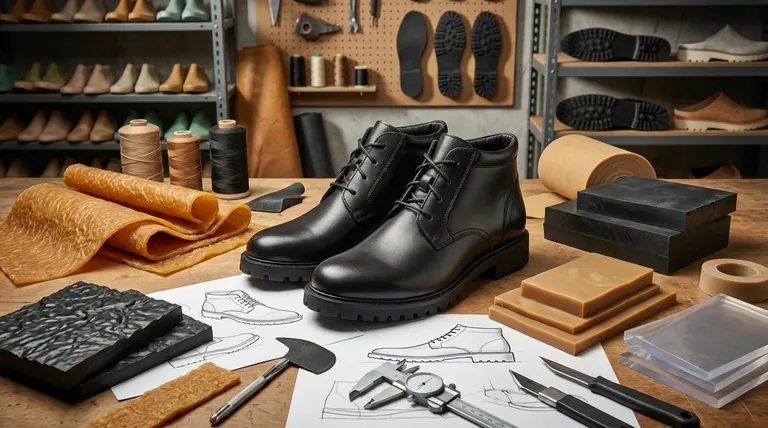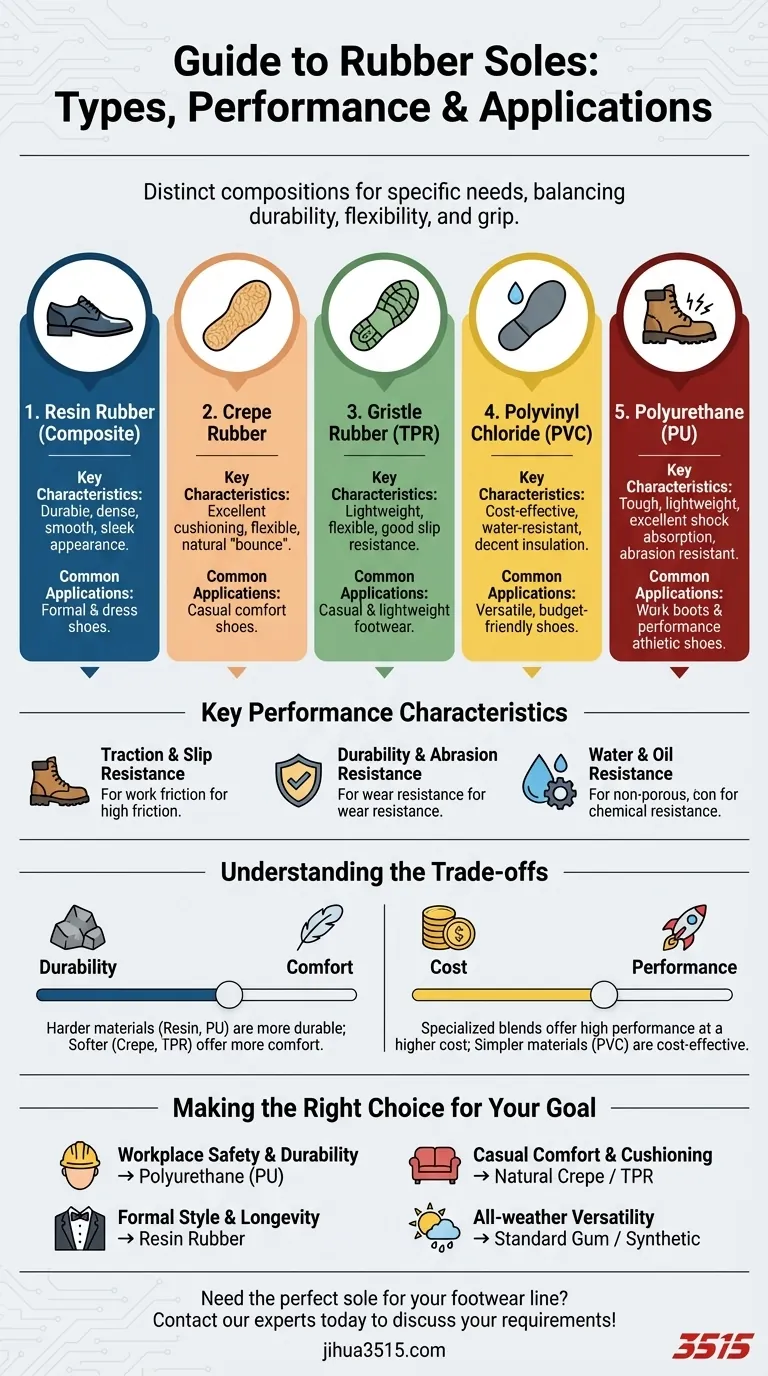In footwear, there are several distinct types of rubber soles, each with unique properties designed for different applications. The primary types mentioned are Resin Rubber, Crepe Rubber, Gristle Rubber, Polyvinyl Chloride (PVC), and Polyurethane (PU). Beyond these specific compositions, rubber soles are also broadly categorized by their material makeup, such as carbon-infused black rubber, fully synthetic crystal rubber, and natural-synthetic gum rubber blends.
The choice of a rubber sole is not just about material; it's about matching the sole's specific performance characteristics—like durability, flexibility, and grip—to the intended use of the shoe, from heavy-duty work to casual comfort.

Understanding the Core Components
Rubber is a default choice for shoe soles because of its inherent durability and protective qualities. Manufacturers manipulate its composition to achieve specific performance goals.
Resin Rubber (Composite)
Resin rubber, often called composite rubber, is a blend of synthetic rubber and plastic resin. This combination creates a hard-wearing, dense, and smooth material.
It is known for its excellent durability and sleek appearance, making it a common choice for formal or dress shoes where longevity is as important as aesthetics.
Crepe Rubber
Crepe rubber is a natural material derived from latex tapped from rubber trees. It is easily identified by its crinkled, porous, and sticky texture.
This sole offers exceptional cushioning and flexibility, providing a very comfortable "bounce" with each step. However, it is less durable and more susceptible to heat and oil damage than synthetic options.
Gristle Rubber (TPR)
Gristle rubber, also known as Thermoplastic Rubber (TPR), is another synthetic blend. It is designed to be extremely lightweight and flexible.
It provides good slip resistance and is often used in more casual footwear where comfort and a lighter feel are the primary objectives.
Polyvinyl Chloride (PVC)
PVC is a type of plastic polymer used to create a lightweight, water-resistant, and cost-effective sole. It is highly versatile in manufacturing.
While durable and offering decent insulation, PVC soles are generally less flexible and provide less grip than traditional rubber, especially in cold or wet conditions.
Polyurethane (PU)
Polyurethane is a polymer prized for its combination of toughness, light weight, and excellent shock absorption. It is a very common material in modern footwear.
PU soles are extremely durable and resistant to abrasion, making them ideal for work boots and high-performance athletic shoes where both comfort and longevity are critical.
Key Performance Characteristics
Different rubber compounds offer distinct advantages based on their makeup. These are often proprietary blends tailored for specific footwear.
Traction and Slip Resistance
Rubber's natural high coefficient of friction provides excellent grip on various surfaces. This is a primary reason it's used for work boots, hiking shoes, and athletic footwear.
Durability and Abrasion Resistance
Synthetic rubber compounds, particularly those infused with carbon (black rubber), are highly resistant to wear and tear. This ensures the sole maintains its integrity and tread over a long period of use.
Water and Oil Resistance
The non-porous nature of most rubber compounds makes them naturally water-resistant. Specific formulations are also designed to resist degradation from oils and chemicals, a crucial feature for safety and work footwear.
Understanding the Trade-offs
No single sole material is perfect for every situation. The choice always involves balancing competing characteristics.
Durability vs. Comfort
Harder, denser materials like resin or polyurethane offer superior durability but can feel stiff. Softer materials like natural crepe provide excellent cushioning but wear down much faster.
Grip vs. Appearance
The sticky, high-traction nature of gum or crepe rubber is excellent for performance but can attract dirt and may not suit a formal aesthetic. Smoother resin soles offer a sleeker look but less grip on slick surfaces.
Cost vs. Performance
High-performance proprietary rubber blends found in specialized work or hiking boots offer advanced features but come at a higher cost. Simpler materials like PVC provide a cost-effective solution but with compromises in flexibility and grip.
Making the Right Choice for Your Goal
Selecting the right sole depends entirely on what you need the shoe to do.
- If your primary focus is workplace safety and durability: Look for polyurethane (PU) or proprietary carbon rubber soles that offer high abrasion, oil, and slip resistance.
- If your primary focus is casual comfort and cushioning: A natural crepe or gristle (TPR) sole will provide superior flexibility and a soft step.
- If your primary focus is formal style and longevity: A resin rubber sole offers a durable, sleek profile suitable for dress shoes.
- If your primary focus is all-weather versatility: A standard gum or synthetic rubber sole provides a balanced blend of traction, water resistance, and durability for everyday wear.
Ultimately, understanding the properties of each sole type empowers you to choose footwear that performs exactly as you need it to.
Summary Table:
| Sole Type | Key Characteristics | Common Applications |
|---|---|---|
| Resin Rubber | Durable, dense, sleek appearance | Formal & dress shoes |
| Crepe Rubber | Excellent cushioning, flexible, natural | Casual comfort shoes |
| Gristle Rubber (TPR) | Lightweight, flexible, slip-resistant | Casual & lightweight footwear |
| PVC | Cost-effective, water-resistant, less flexible | Versatile, budget-friendly shoes |
| Polyurethane (PU) | Tough, lightweight, excellent shock absorption | Work boots & performance athletic shoes |
Need the perfect sole for your footwear line?
As a large-scale manufacturer, 3515 produces a comprehensive range of footwear for distributors, brand owners, and bulk clients. Our production capabilities encompass all types of shoes and boots, and we can guide you in selecting the ideal rubber sole compound—whether it's durable PU for work boots or comfortable crepe for casual styles—to meet your specific performance and market demands.
Contact our experts today to discuss your sole material requirements and get a customized solution!
Visual Guide

Related Products
- Wholesale Leather Ankle Boots with Lug Soles for Custom Brand Manufacturing
- Wholesale Comfortable Business Casual Shoes Custom Manufacturing
- Custom OEM Training Shoes Wholesale Manufacturer Durable & Breathable
- Wholesale Leather Work Boots with Customizable Wedge Sole for Brands
- Safety Footwear Wholesale Manufacturer for Custom OEM/ODM Production
People Also Ask
- What are the benefits of classic black lace moc toe shoes? Achieve Polished, Versatile Style
- Is heavy, stiff footwear necessary for good ankle support? The Truth About Boot Design & Injury Prevention
- Why is comfort important in dress shoes? Achieve All-Day Support for Professional Performance
- What types of dress shoes are recommended for formal occasions? A Guide to Impeccable Style
- Why are high quality leather linings important for boots? Enhance Comfort, Durability & Foot Health



















